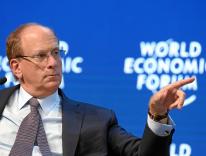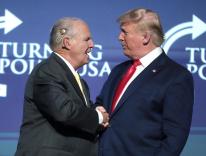My man Joe Nocera was on the Lehrer "News Hour" last evening. That he reminded me of my Uncle Ben from Brooklyn is another point in his favor.Two of the words he used in talking about the latest A.I.G. bailout were "counterparty" and "blackhole." And, lo, they appear prominently in today's Times' editorial.
In a joint statement with the Federal Reserve on Monday, the Treasury justified the move, saying that the potential cost to the economy and the taxpayer of government inaction would be extremely high.Thats a textbook rationale for any bailout. What no one is saying the Bush folks wouldnt, and the Obama team seems to have taken the same vow of Wall Street omert is which firms would be most threatened by an A.I.G. collapse. The Treasury and the Federal Reserve noted in their statement that A.I.G. is a significant counterparty to a number of major financial institutions.That means that by enabling A.I.G. to avert bankruptcy proceedings, the taxpayer is also bailing out whom exactly?Not knowing is not acceptable. At this stage of a deepening crisis, no one is arguing that the government should let A.I.G. collapse into a disorderly bankruptcy. It is too interconnected. During the housing bubble, it used unregulated derivatives to insure mortgage securities that turned out to be toxic without putting aside reserves in case it had to pay up. If it now went under, there could be a chain of catastrophic defaults among banks that hold the securities and related investments.The A.I.G. bailouts fail the basic test of transparency: Who ends up with the money? Major financial institutions are not innocent victims of A.I.G.s demise. They are sophisticated investors, and they should have known the risks being taken and who profited mightily from the relationship before it all came crashing down.Whomever the recipients are, they should be investigated for their roles in the crash and, to the extent possible, be made to pay for the bailouts.
The editorial goes on to suggest some interesting connections:
The serial A.I.G. bailouts are especially problematic for their connection to the Wall Street bank Goldman Sachs. At the time of the first A.I.G. rescue last fall, it was reported by Gretchen Morgenson in The Times that Goldman was A.I.G.s largest trading partner, with some $20 billion of business tied into the insurer. Goldman has said that its exposure to risk from A.I.G. was offset, or hedged, by other investments.What is certain is that Goldman has lots of friends in high places yet one more reason why this bailout has to be as transparent as possible. Lloyd Blankfein, Goldmans chief executive, was the only Wall Street executive at a September meeting at the New York Federal Reserve to discuss the initial A.I.G. bailout. Also involved in the discussion was the then head of the New York Fed, Timothy Geithner, who is now President Obamas Treasury secretary.
A related story in the "Business Section" delves further into the Byzantine developments:
The company said Monday that it would create a new holding company, called A.I.U. Holdings, and install its domestic and foreign property and casualty insurance businesses there with more than 44,000 employees and customers in 130 countries.That company will be run by senior A.I.G. insurance executives, and its name comes from an existing A.I.G. business, American International Underwriters.But the goal is to break this new property insurer free of A.I.G. and its many complications. A.I.G.s conglomerate structure is too complicated, unwieldy and opaque, said Edward Liddy, who was brought in as chief executive by the government last fall when the conglomerate nearly collapsed. While announcing the details of the latest government package and the companys fourth-quarter loss of $61 billion, he emphasized that the company does not need cash.But to satisfy the government loans, he has been trying to sell divisions, a fact made harder because of A.I.G.s opaque structure.Mr. Liddy also took a jab at A.I.G.s former chief executive, Maurice R. Greenberg, saying he was the one who oversaw A.I.G.s foray into derivatives. That business has literally brought us to our knees, he said on Bloomberg television.Mr. Greenberg, known as Hank, fired back with a lawsuit against A.I.G., which he accused of securities fraud.
A.I.G. + A.I.U. = I.O.U.P.S.: my "uncle" Joe said that 350 people in the London office of A.I.G. were responsible for bringing down a company that had 100,000 employees worldwide.
Please email comments to [email protected] and join the conversation on our Facebook page.
Previous Story
Whose party is it, anyway?
Next Story
Scouring off the rust


